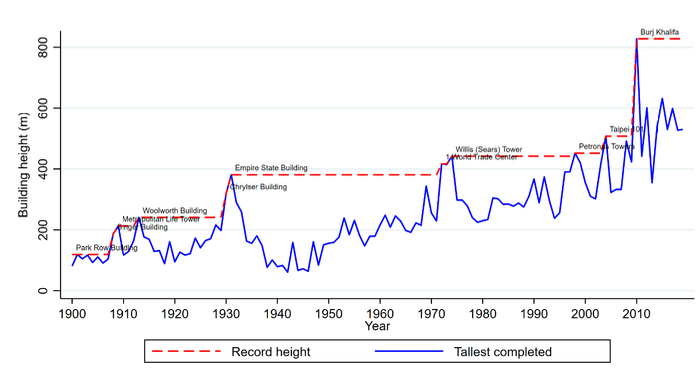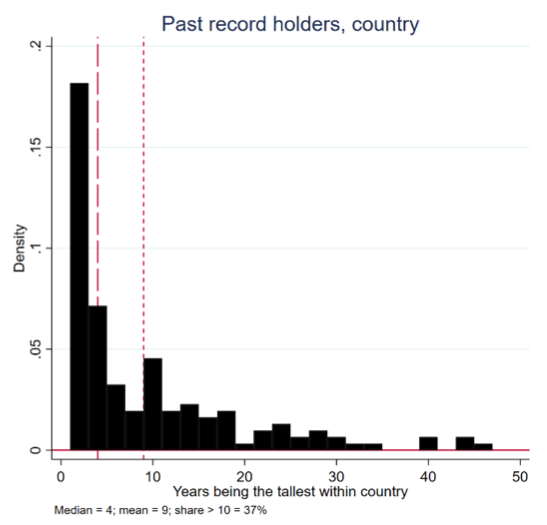A hundred years ago, policymakers in New York were convinced that ‘few skyscrapers pay large net returns…’ and that ‘the very tall buildings demand many things out of proportion to their increased bulk’ (Heights of Buildings Commission 1913). Despite their sentiments, their belief in the death of the skyscraper was premature. The Empire State Building, which was viewed as nothing short of maniacal in 1931, is now decidedly second tier (the 41st tallest structure in the world). In 2010, the Burj Khalifa, at 828 metres high, set the new record for the world’s tallest building. Industry experts felt that its height was driven by developers’ egos rather than compelling economics (Tomlinson 2016). Still, history may put it in perspective, too, as new record-breaking projects are already underway (The Skyscraper Center, n.d.).
While the study of the horizontal spatial structure of cities (Ahlfeldt et al. 2014) has flourished since the early neoclassical work summarised by Brueckner (1987), the vertical dimension has long received less attention. Though with a significant delay, economics research has recently responded to the vertical growth of global cities. In our recent paper, we synthesise the theoretical and empirical advances to put supertall buildings into perspective (Ahlfeldt and Barr 2020).
The role of fundamentals
Figure 1 shows the time series of the height of the tallest building completed each year around the world from 1900 to 2019, along with the height of the world’s tallest building. There is a reasonable and sustainable long-run trend, suggesting a role for economic fundamentals. The average annual trend rate for the tallest structures is 1.3%. As a comparison, since 1960, real global GDP has had a trend of 3.2% (World Bank 2020).
Figure 1 Height of the tallest building completed each year globally (1990–2019)
Source: Ahlfeldt and Barr (2020).
Modelling and measuring the role of fundamentals is fairly straightforward. Developers face average construction costs that rise at an increasing rate with height since taller buildings require more sophisticated structural engineering (to withstand lateral wind forces), facilities such as elevators, and expensive building materials (Ahlfeldt and McMillen 2017).
Average revenues also increase with height due to an amenity and signalling value (Liu et al. 2018). Intuitively, developers build up to the economic height, where the marginal cost of adding a floor equates to the marginal return. If costs of height exceed returns at the margin, there is a finite solution and a one-to-one mapping from a location-specific rent to the economic height.
This simple framework can aid in rationalising the trend toward taller buildings. First, urban land – a critical input in the production of floor space – is provided inelastically. This implies that rents generally increase in real terms over time, raising the incentives to build taller buildings, even with all other things constant. If the amenity value of height rises over time, this further pushes up average heights.
Perhaps the most obvious factor, however, is the cost of producing building height. The inventions of the electric elevator and steel-framed structure at the end of the 19th century removed many of the previous barriers to building tall. Since then, constant technological improvements have reduced the marginal cost of adding height.
Figure 2 gives a theoretical example that expands the standard two-dimensional land-use model to incorporate the costs and returns to building height. The main takeaway is that even moderate reductions in construction costs can lead to substantial increases in building heights in places where rents are high, such as in central business districts in major cities.
Consistent with the role of fundamentals, empirical research shows that factors that predict floor-space prices, such as distance from the central business district, natural amenities, or city size and density (Ahlfeldt and Pietrostefani 2019), are also strong predictors of building heights. There is also a close correlation between land prices and building heights over space and time.
Figure 2 Distance from central business district and building height
Source: Ahlfeldt and Barr (2020).
Non-economic motives
Returning to Figure 1, some buildings stand out as particularly tall relative to the trend and remain relatively tall for a very long time. This has fuelled the suspicion that some developers may have non-profit-maximising objectives. Helsley and Strange (2008) model skyscraper development as a race to gain personal satisfaction by having the tallest building. In equilibrium, the winning developer builds a much taller structure than the economic height to pre-empt would-be competitors.
While the theory is elegant, buildings used to pre-empt rivals appear not to be the rule but rather the exception, as shown in Figure 3. As of 2015, only three buildings in the world held the title of world’s tallest for more than ten years (the Burj Khalifa recently joined this club). The median is just six years. Within countries, the mean record length is less than ten years, and the median is only four. This fast succession substantiates the notion that long-run trends in economic fundamentals are essential drivers of vertical growth.
Figure 3 Years of holding tallest building record
Source: Ahlfeldt and Barr (2020).
Yet, there are exceptions, and the most impressive is the Empire State Building, which topped the world height ranking for 40 years (the outlier in the top panel). Its economics were frequently called into question – it was called the ‘Empty State Building’ during the Great Depression. While it cost a historically impressive $50 million for the land and structure (in roughly 1930 dollars), by 1950, its net operating income was about $6.8 million, thus exceeding 10% of the inflation-adjusted total cost. Its net income has increased over the years in real terms, on average (not least, thanks to the observation deck, which nowadays generates $130 million per year alone). This case study further adds to the notion that a skyscraper’s economics may be rejected too casually.
The policy dimension
As the heights of buildings continue to rise, the controversy about skyscrapers being too tall renews itself every generation. As a result, tall buildings remain controversial, and there are frequent public outcries to limit building heights or to regulate them strictly. Critics complain that tall buildings are ugly, are incompatible with the ‘human scale’ that Jane Jacobs (1961) argued for, or are drivers of income inequality and gentrification. They also denounce the shadows and urban congestion they may create. That skyscrapers also appear irrational and unsustainable from a business perspective is frequently cited to strengthen the case against them.
Although skyscrapers have been around for over a century, the comprehensive quantification of their negative and positive externalities remains an item on the economics research agenda. For example, we know little about how shadows from a tall building may affect the property values of nearby buildings or how they may affect the social value of parks that they surround.
Regulations can be used to reduce negative externalities. But if taken too far, strict regulations can generate unintended consequences, such as higher housing prices and urban sprawl (Brueckner et al. 2017). Policymakers need to consider this trade-off carefully and, hopefully, economists can assist with quantitative models. The question of whether oversized egos drive developers is perhaps second-order from a policy perspective.
Being able to draw an exact line between the economic rationale and irrational developments is also for future research. But in the meantime, we are safe in concluding that the vast majority of tall buildings – even if they appear out of scale given contemporary perceptions – have a solid economic case. If the history of height is any guide, the future direction for their economics is only upwards.
References
Ahlfeldt, G, and J Barr (2020), “The economics of skyscrapers: A synthesis,” CEPR Discussion Paper 14987.
Ahlfeldt, G, and D McMillen (2017), “Skyscrapers and land values: Evidence from Chicago on the costs of building tall cities”, VoxEU.org, 4 November.
Ahlfeldt, G, and E Pietrostefani (2019), “The economic effects of density: A synthesis”, VoxEU.org, 22 February.
Ahlfeldt, G, S Redding, D Sturm and N Wolf (2014), “The economics of density: Evidence from the Berlin Wall”, VoxEU.org, 20 August.
Brueckner, J (1987), “The structure of urban equilibria: A unified treatment of the Muth-Mills model”, Handbook of Regional and Urban Economics 1(2): 821–45.
Brueckner, J, S Fu, Y Gu and J Zhang (2017), “Measuring the stringency of land-use regulation: The case of China”s building height limits”, Review of Economics and Statistics 99(4): 663–77.
Heights of Building Commission (1913), Report of the Heights of Buildings Commission to the Committee on the Height, Size and Arrangement of Buildings of the Board of Estimate and Apportionment of the city of New York, New York: MB Brown Printing and Binding.
Helsley, R W, and W C Strange (2008), “A game-theoretic analysis of skyscrapers”, Journal of Urban Economics 64(1): 49–64.
Jacobs, J (1961), The death and life of great American cities, New York: Random House.
Liu, C, S S Rosenthal and W C Strange (2018), “The vertical city: Rent gradients and spatial structure”, Journal of Urban Economics 106: 101–22.
The Skyscraper Center (n.d.), “100 tallest under construction buildings in the world by height to architectural top”, Council on Tall Buildings and Urban Habitat.
Tomlinson, P (2016), “Time to take the ego out of skyscrapers, say renowned architect”, South China Morning Post, 26 November.
World Bank (n.d.), “GDP (constant 2010 US$)”, online database.







